|
|
Part One Historical Evolution
(1) Founding
In June 1950, the Institute of Mathematics was under preparation soon after the Chinese Academy of Sciences (CAS) was founded, and many things were waiting to be done. The preparation office was located at No.3 Wenjin Street in Beijing. The well-known mathematician Su Buqing was the director, Zhou Peiyuan, Jiang Zehan, Hua Luogeng and Xu Baolu were the deputy directors of the office, and Tian Fangzeng was the secretary. The central government of the country attached great importance to the founding of the institute. In January 1951, the State Council approved the appointment of Hua Luogeng as the director of the Institute of Mathematics to be founded. In July 1, 1952, the institute was established and located on the campus of Tsinghua University. The institute decided to focus its research on coordinated development of pure mathematics and applied mathematics. The first research groups were set up to study number theory, differential equations, mechanics, computer development, probability and statistics, algebra, and topology.
In the first half of 1953, there were 32 researchers in the institute, including 5 research professors (Hua Luogeng, Min Naida, Wu Xinmou, Zhang Sucheng, Wu Wenjun), 5 associate research professors (Guan Zhaozhi, Tian Fangzeng, Wang Shouren, Zhuang Fenggan, Xia Peisu), 6 assistant research professors (Lin Hongsun, Sun Yifeng, Yue Minyi, Feng Kang, Wan Zhexian, Hu Haichang), 11 research trainees (Lu Qikeng, Gong Sheng, Hu Hesheng, Zhang Liqian, Wang Guangyin, Qiu Peizhang, Ding Xiaqi, Xu Kongshi, He Shanyu, Sun Hesheng, Wang Yuan), and 5 joint research professors (Su Buqing, Chen Jiangong, Duan Xuefu, Hu Shihua, Zhang Zongsui). The directions they started laid foundations for the development of the institute. Only among those 32 people, 17 were electedacademicians (Members) of the CAS. |
 |
 |
 |
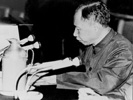 |
 |
| Picture 1 |
Picture 2 |
Picture 3 |
Picture 4 |
Picture 5 |
Picture 1 Prof.Hua Loo-Keng, Deputy of the preparation office of the Institute of Mathematics, CAS.
Picture 2 Prof.Hua Loo-Keng in 1953.
Picture 3 Prof.Wu Wentsun in 1953.
Picture 4 Prof.Guan Zhaozhi in 1953.
Picture 5 Prof.Hua Loo-Keng and the researchers of the Institute of Mathematics in August in 1953.
(2) Marching Towards Science
In 1956, the state formulated the 12-Year Program for the Development of Science and Technology. While ensuring a coordinated development of major aspects of mathematical research, the Institute of Mathematics prioritized the development of differential equations, probability and statistics, which were closely related to the national economy and national defence. It also set up the research groups on functional analysis and mathematical logic to intensify the theoretical study of relevant subjects. In 1957, Professor Xiong Qinglai, who returned from France, founded the research group of the theory of functions. In this period, the research work related to mechanics and computer development managed affairs on their own to build the Institute of Mechanics and the Institute of Computing Technology of the CAS. Encouraged by the 12-Year Program for the Development of Science and Technology, the institute started its march towards science.
In 1956, China granted the first National Natural Science Award. Of the three top prizes, the Institute of Mathematics won two.
The institute was temporarily moved to Xiyuan Hotel in 1957. In the next year, it was moved to Zhongguancun (the northern building of the Institute of Computing Technology).
In 1961, research divisions were set up according to subjects, including "four branches" (number theory, algebra, geometry, topology), function theory, differential equations, functional analysis, mathematical logic, theoretical physics, probability and statistics. The Division of Operations was formed with related groups in the Institute of Mechanics and the Institute of Mathematics proposed by Qian Xuesen, Hua Luogeng and Xu Guozhi. In 1962, responding to the needs of our country, the Division of Control Theory was established under the leadership of Guan Zhaozhi and Song Jian. Later, the Division of Mechanics was reestablished. The research work in various directions carried forward rapidly. From 1961 to 1965, following the policy of gaining both achievements and talents, the institute had a relatively stable developing period preparing for the future.
After the "cultural revolution" started in 1966, all research stopped. In 1972, Premier Zhou Enlai gave instruction on intensifying basic research, so mathematical research started again. In 1973, Chen Jingrun made public his result on the Goldbach conjecture. In 1975, Yang Le and Zhang Guanghou published their result on the value distribution theory. The finite element algorithm, founded by Feng Kang et al. in the early 1960s independently of the West, was applied widely in many branches of the national economy and national defence. These were the symbolic achievements of mathematical research of our institute's scientists who had been working at an extremely difficult time. |
 |
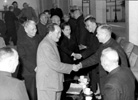 |
 |
 |
|
|
Picture 1 |
Picture 2 |
Picture 3 |
Picture 4 |
|
Picture 1Mao Zedong with Hua Loo-Keng in 1958.
Picture 2Mao Zedong and Liu Shaoqi with Hua Loo-Keng in 1962.
Picture 3Zhou Enlai with Hua Loo-Keng in 1958.
Picture 4The finite element algorithm, founded by Feng Kang et al. in the early 1960s independently of the
West, was applied widely in many branches o f the national economy and national defence. |
 |
 |
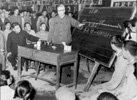
|
|
|
|
Picture 5 |
Picture 6 |
Picture 7 |
|
|
- Picture 5Yang Lo and Zhang Guanghou, and their paper on the value distribution theory published in Scientia Sinica.
- Picture 6Prof.Chen Jingrun and his paper on the Goldbach conjecture published in Scientia Sinica.
- Picture 7Prof.Hua Loo-Keng explained the optimal selection method with workers.
|
(3) Springtime of Science
After the "gang of four" was smashed in 1976, especially after the National Science Congress was held in 1978, China greeted a springtime of science. At such a time when knowledge is respected and talents are honored, the researchers of the institute spared no efforts to keep up with the latest development of mathematical study, making rapid headway in pure and applied mathematics and pushing China's mathematical study onto a track of healthy development.
In 1977, the Computing Center of the CAS, mainly engaged in the research of computational mathematics, was established and located at No.4 South 4th Street, Zhongguancun. From this the Institute of Computational Mathematics and Scientific/Engineering Computing was formed in 1995. The successive directors of the institute were Feng Kang, Shi Zhongci, Cui Junzhi, and presently Yuan Yaxiang. At the end of 1979, the CAS decided to separate part of the personnel from the Institute of Mathematics to set up the Institute of Systems Science, whose task is to study control theory, operations and management, statistics, systems engineering, and related boundary sciences of mathematics. The successive directors of the institute were Guan Zhaozhi, Cheng Ping, Chen Hanfu, and presently Guo Lei. Part of the personnel of the Institute of Mathematics was merged with the former Promotion Office of Applied Mathematics of the CAS to form the Institute of Applied Mathematics. The successive directors of the institute were Hua Luogeng, Wu Fang, Zhang Xiangsun, and presently Ma Zhiming. The Institute of Mathematics mainly focuses on basic theoretical research as well as applied mathematics and computer science. Its successive directors were Hua Luogeng, Lu Qikeng (executive vice-director), Wang Yuan, Yang Le, Long Ruilin, Li Bingren (acting director), and presently Wang Yuefei. The researchers in the four institutes have been working on different subjects while maintaining good cooperation, resulting in a large number of achievements and talents. In 1982, when the state resumed the granting of the National Natural Science Award, the four institutes were again in the spotlight with their high-level scientific results. In 1991, the later three institutes were moved to No.A1, South 4th Street, Zhongguancun. |
 |
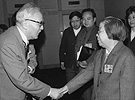 |
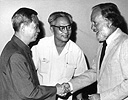 |
 |
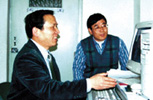 |
| Picture 1 |
Picture 2 |
Picture 3 |
Picture 4 |
Picture 5 |
Picture 1Deng Xiaoping and Chen Jingrun at the National Science Congress
Picture 2Hua Loo-Keng and Deng Yingchao.
Picture 3Wu Wentsun and Fang Yi met foreign mathematicians.
Picture 4Li Peng and Wu Wentsun.
Picture 5Li Peng met Guo Lei |
 |
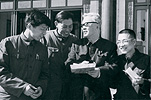 |
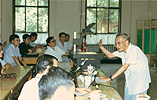 |
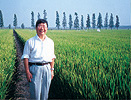 |
|
| Picture 6 |
Picture 7 |
Picture 8 |
Picture 9 |
|
Picture 6S.S.Chern visited the institute and made a speech.
Picture 7Hua Loo-Keng, Chen Jingrun, Yang Lo and Zhang Guanghou attended the National Science Congress in
1978.
Picture 8Feng Kang at an academic conference.
Picture 9Chen Xikang presented the grain output forecast of China. This project won the National Science &
Technology Progress Award (third class) and IFORS Prize (first class)
(4 ) Historical Opportunities
In December 1998, as part of the National Knowledge Innovation Program of the CAS, the Institute of Mathematics, Institute of Applied Mathematics, Institute of Systems Science and Institute of Computational Mathematics and Scientific/Engineering Computing were merged into the Academy of Mathematics and System Sciences (AMSS). Yang Le is the president and Zhang Xiangsun is the executive vice-president of the AMSS. Since its founding, the AMSS has launched a series of major reforms, especially in adjusting structure and transforming the management mechanism; condensing research subjects and clarifying the main targets; improving the environment of the compound and building innovation culture. The work has been proceeding rapidly, and achieving obvious results. The knowledge innovation program has brought about new opportunities to the development of mathematics and system sciences.
The Institute of Mathematics set up the Division of Basic Mathematics, the Division of Non-linear Analysis, the Young Research Center of Geometric Analysis, the Division of Computer Science, and the Morningside Center of Mathematics. The Institute of Applied Mathematics set up the Division of Operations, the Division of Probability and Statistics, the Division of Differential Equations and Computing, and the Division of Decision and Information Science. The Institute of Systems Science set up the Key Laboratory of Systems and Control, the Key Laboratory of Management, Decision and Information Systems, the Division of Statistical Science, the Division of Pure and Applied Mathematics, and the Mathematics Mechanization Research Center. The Institute of Computational Mathematics and Scientific/Engineering Computing set up the State Key Laboratory of Scientific and Engineering Computing. The AMSS has built the Laboratory of Graph Theory and Combinatorics, the Research Center of Decision Making under Uncertainty, and the Information Security Center. The AMSS is also preparing to build the Research Center of Dynamic Systems, the Research Center of Financial Mathematics, the Research Center of Biological Information, etc. These research centers go beyond a single branch and reflect new increasing interests. They are in keeping with the strategic requirements of our country, and will help to promote interdisciplinary sciences.
The Chinese Mathematical Society, the Operations Research Society of China, the Systems Engineering Society of China et al. set up their offices in the AMSS. The AMSS sponsor 14 academic journals. |
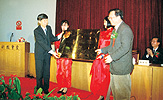 |
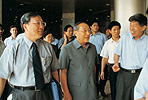 |
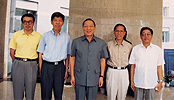 |
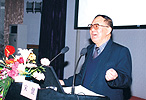 |
|
| Picture 1 |
Picture 2 |
Picture 3 |
Picture 4 |
|
Picture 1 The inaugural meeting of AMSS
Picture 2 Vice Premier Li Lanqing and CAS President Lu Yongxiang inspected AMSS.
Picture 3 Vice Premier Li Lanqing and part of leaders of AMSS.
Picture 4 Song Jian (Vice Chairman of CPPCC, Honorary Professor of AMSS) gave and academic talk.
Part Two Fruitful Research
In the past 50 years, the scientific personnel of the four institutes has made important contributions to the country's development of mathematics and system sciences as well as the construction in national economy and national defence. They have won more than 400 scientific awards, including one National Top Science and Technology Award, four first-class prizes of the National Natural Science Award, and some important international awards. Some important research achievements in applied sciences have been acknowledged by the central government leaders and relevant divisions of application. This has proved the important role of mathematical theory in the main fronts of the national economy.
Chairman Jiang Zemin vested Wu Wentsun the first
National Top Science and Technology Award.
National Natural Science Award (first class)
The theory of functions of several complex variables over classical domains (Hua Luogeng, 1956)
Studies on characteristic classes and embedding classes (Wu Wentsun, 1956)
Studies on the Goldbach conjecture (Chen Jingrun, Wang Yuan, Pan Chengdong, 1982)
Symplectic geometric algorithm of Hamiltonian systems (Feng Kang et al., 1997)
National Natural Science Award (second class)
The theory of value distribution of entire and meromorphic functions (Yang Le, Zhang Guanghou, 1982)
Control theory of elastic vibration of flying equipments (Song Jian, Guan Zhaozhi et al., 1982)
The finite element method (Feng Kang, Huang Hongci et al., 1982)
Fluid elastic models and applications to nuclear explosion and armour-piercing (Li Yinfan as a main participant, 1982)
Complex geometry and related problems (Zhong Jiaqing, 1987)
Compensated compactness principle and the system of equations of isentropic gas dynamics (Ding Xiaqi et al., 1989)
Studies on the global properties of quantum field theory (Wang Shikun as a main participant, 1989)
Non-linear differential equations and applications to geometry (Ding Weiyue, 1993)
Dirichlet forms and stochastic analysis (Ma Zhiming, Yan Jiaan, 1995)
Studies on the Stener tree (Du Dingzhu, 1995)
New development of theory and algorithms of mechanization of geometric theorem proving (Gao Xiaoshan as a main participant, 1997)
National Natural Science Award (third class)
Studies on dominant eigenvalues of transport operators (Yang Mingzhu, Zhu Guangtian, 1982)
Difference method of initial boundary value problems and rotational flow (Zhu Youlan et al., 1982)
Isomorphism theory of classical groups (Wan Zhexian et al., 1987)
Classical manifolds and classical domains (Lu Qikeng, 1987)
Optimization theory and algorithms (Yue Minyi, Wu Fang, Han Jiye et al., 1987)
Identification and adaptive control for dynamical systems (Chen Hanfu, Guo Lei, 1987)
The finite element theory and methods (Shi Zhongci, 1989)
Fundamental theory of adaptive estimation and control (Guo Lei, Chen Hanfu, 1997)
Robust analysis and synthesis of control systems of parameter perturbation (Wang Enping as a main participant, 1999)
National Science & Technology Progress Award (special class)
The general-purpose satellite Jianbing No.1 and the satellite Dongfanghong No.1 (Guan Zhaozhi as a main participant, 1985)
National Science & Technology Progress Award (first class)
Quantitative studies of population systems and applications (Zhu Guangtian as a main participant, 1987)
Systematic optimization of technological parameters of extracting vanadium (Xu Weixuan, Xu Zhongling as main participants, 1988)
National Science & Technology Progress Award (second class)
Unified design standards of building structure (Liu Yuanzhang as a main participant, 1986)
Numerical methods of seismic prospecting (Feng Kang, Zhang Guanquan et al., 1987)
Disposition model of agricultural time and space developing of Huang-Huai-Hai Plain (Wang Yuyun as a main participant, 1988)
"Heaven Steed" --- A general-purpose and integrated expert system development environment (Lu Ruqian, 1993)
Automatically generating system of finite element programs (Liang Guoping, 1995)
- National Science & Technology Progress Award (third class)
Throwing and producing tables of the nationwide agriculture and applications (Chen Xikang et al., 1987)
Mathematics software base STYR (Xu Xianyu, Zhang Yixia et al., 1987)
Remote sensing reexamination of agricultural resources of Sanjiang Plain and suggestions for comprehensive administration (Shu Guangfu, Gu Jifa as main participants, 1988)
Statistics software package SASD (Zhang Jianzhong, Yang Ziqiang et al., 1989)
Characteristic evaluation of oil and gas resources by unstable well-testing method (Yu Qihuang, Wu Shengchang et al. as main participants, 1991)
Studies and evaluation of ecology environment and social economic conditions of upper reaches of the Yangtze River (Wang Yuyun as a main participant, 1995)
Software system CADCSC of computing and auxiliary design of control systems of China (Han Jingqing, Xu Kekang, 1995)
Grain output forecast of China (Chen Xikang et al., 1996)
Automation system project of water conservancy drawing the Qing River (Zhang Yongguang as a main participant, 1996)
Value distribution theory and new development (Yang Le, 1997)
Analysis of national conditions of China (Chen Xikang as a main participant, 1998)
CAS Science & Technology Achievement Award (first class)
Popularizations and applications of general programming and optimal selection method in Sichuan and Inner Mongolia (Hua Luogeng et al., 1980)
Optimal selection technology of saving oil and general programming of railway transportation (Hua Luogeng et al., 1980)
Mechanization proving (Wu Wenjun, 1980)
Studies, applications and popularizations of total quality management (Liu Yuanzhang, 1980)
A project of series software (Lu Ruqian, 1981)
The optimization theory and applications (Yue Minyi, Wu Fang, Xu Guanghui, Han Jiye et al., 1981)
Applications of general programming and optimal selection method to planning, management decision and demonstration of major projects (Chen Dequan, Li Zhijie, Ji Lei et al., 1981)
Studies on isolators of non-linear waves (Tu Guizhang, Wu Huamo, Qin Mengzhao, 1981)
Applications of number theory to approximate computing (Hua Luogeng, Wang Yuan, 1983)
CAS Natural Science Award (first class)
Compensated compactness and the system of equations of gas dynamics (Ding Xiaqi et al., 1988)
The extrapolation method of the finite element (Lin Qun et al., 1989)
The regular boundary element method and adaptive boundary element method (Yu Dehao, 1989)
Symplectic geometric algorithm of Hamiltonian systems (Feng Kang, Qin Mengzhao et al., 1990)
Dirichlet forms and stochastic analysis (Ma Zhiming, Yan Jiaan, 1992)
Studies on the Stener tree (Du Dingzhu, 1993)
Studies on adaptive estimation and control (Guo Lei, Chen Hanfu, 1994)
Minimal surfaces on manifolds (Wang Guangyin, Ji Min, 1995)
New development of theory and algorithms of mechanization of geometric theorem proving (Gao Xiaoshan as a main participant, 1995)
Singular integrals of several complex variables (Sun Jiguang as a main participant, 1996)
Geometry of classical groups over finite fields and applications (Wan Zhexian, 1997)
The theory, equations and numerical method of parabolized proliferation of fluid movement (Wang Ruquan as a main participant, 1997)
Function theory of several complex variables and Lie groups (Zhou Xiangyu, 1999)
Geometric function theory of several complex variables (Yu Qihuang, Wang Shikun as main participants, 2000)
Variational models and set-valued analysis in vector optimization (Chen Guangya, Wang Shouyang, 2001)
- CAS Science & Technology Progress Award (special class)
Disposition model of agricultural time and space developing of Huang-Huai-Hai Plain (Wang Yuyun as a main participant, 1987)
CAS Science & Technology Progress Award (first class)
Non-linear shift registers (Wan Zhexian et al., 1986)
Numerical methods of seismic prospecting (Feng Kang, Zhang Guanquan et al., 1986)
Mathematics software base STYR (Xu Xianyu, Zhang Yixia et al., 1986)
General-purpose finite element program system (Cui Junzhi et al., 1986)
Disturbance theory of the generalized eigenvalue problem (Sun Jiguang, 1986)
The finite element theory and methods (Shi Zhongci, 1987)
Studies on the global properties of quantum field theory (Wang Shikun as a main participant, 1987)
Statistics software package SASD (Zhang Jianzhong, Yang Ziqiang et al., 1988)
Characteristic evaluation of oil and gas resources by unstable well-testing method (Yu Qihuang, Wu Shengchang et al. as main participants, 1990)
Comprehensive administration method and strategy research for agricultural development of Huang-Huai-Hai Plain (Wang Yuyun as a main
participant, 1991)
"Heaven Steed" --- An expert system development environment (Lu Ruqian, 1992)
Studies on the grain output forecast of China (Chen Xikang et al., 1992)
Studies and evaluation of ecology environment and social economic conditions of upper reaches of the Yangtze River (Wang Yuyun as a main participant, 1992)
Chen Jiageng Award
Hua Loo-Keng & Wang Yuan (1990) Wu Wentsun (1993) Yang Lo (1998)
Outstanding Scientist Award of Qiushi Fund
Wu Wenjun (1994)
Science & Technology Progress Award of He-Liang-He-Li Fund
Chen Jingrun (1994) Wang Yuan (1994) Yang Le (1998) Ma Zhiming (1999)
Ding Xiaqi (2000) Shi Zhongci (2000) Lu Qikeng (2001)
Young Scientist Award of China
Du Dingzhu(1992) Guo Lei(1994) Yuan Yaxiang(1996)
Young Science & Technology Award of China
Guo Lei(1990) Wang Shouyang(1994) Zhang Liqun(2004)
Chen Zhiming(2006) Hong Yiguang(2006) Yang Xiaoguang(2006)
A partial list of important international awards
Mathematics Award of the Third World Academy of Sciences (Wu Wentsun, 1992)
Max-Planck Research Award (Albeverio, Zhiming Ma, Roeckner, 1992)
IFAC Young Author Prize (Guo Lei,1993,Hong Yiguang,1999)
Outstanding Prize of the Hardy-Ramanujian Society of India (Jia Chaohua, 1995)
IFORS Prize for Operational Research in Development (first class) (Zhang Xiangsun, Cui Jinchuan, 1996)
Herbrand Award for Distinguished Contributions to Automatic Reasoning (Wu Wentsun, 1997)
The Humboldt Research Award of The Alexander-von Humboldt Foundation of Germany(Zhu, Lixing, 1998)
IFORS Prize for Operational Research in Development (first class) (Chen Xikang et al., 1999)
Harrington-Ishkawa Award (Liu Yuanzhang, 2000)
Citation Classic Award (Chen Guangya, 2000)
Mathematical Science Achievement Award by Czech Academy (Lin Qun, 2001)
Part Three The Graceful Bearing of Academicians
The AMSS now has 15 CAS academicians and two CAE (Chinese Academy of Engineering) academicians. Photos 85-101 show CAS academicians Wu Wenjun, Wang Yuan, Yang Le, Lu Qikeng, Ding Xiaqi, Wan Zhexian, Shi Zhongci, Lin Qun, Chen Hanfu, Ma Zhiming, Ding Weiyue, Yan Jiaan, Lu Ruqian, Li Banghe, Guo Lei, and CAE academicians Cui Junzhi, Liu Yuanzhang.
Academicians who have passed away are Hua Loo-Keng, Zhang Zongsui, Feng Kang, Guan Zhaozhi, Chen Jingrun and Xu Guozhi.
Researchers who worked at the Institute of Mathematics and were later elected academicians are Su Buqing, Chen Jiangong, Duan Xuefu, Zhuang Fenggan, Hu Shihua, Dai Yuanben, Hu Haichang, Hu Hesheng, Song Jian, Xia Peisu and Tang Zhisong.
Part Four Domestic and International Academic Exchanges
Since 1956, the Institute of Mathematics has increased the exchanges with domestic institutions of higher learning through holding training sessions and receiving teachers for training. Many mathematicians from universities benefited from the training and later became mainstays of various fields. The international cooperation and exchanges in the 1950s were mainly conducted with the socialist countries. After the reform and opening-up policy began in 1978, a large number of researchers went abroad and engaged in cooperative research and extensive exchanges with foreign counterparts.
In 1985, advocated by Director Wang Yuan, the Institute of Mathematics became one of the first institutes of the CAS that were opened to foreign scientists. Soon, the other three institutes also set up open laboratories, which received visiting scholars from both home and abroad in light of the principle of "opening, flowing, integrating, and gearing the research to the country and the world".
In recent three years, 719 person/times of visits abroad were made by researchers of the AMSS, who also received 1,055 visitors (including 604 overseas scholars and 451 domestic visitors). From 1999 to 2001, the AMSS also sponsored or co-sponsored 25 major international conferences or seminars. More than 70 academic workshops are being held regularly every year. |
 |
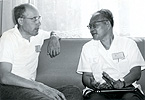 |
 |
 |
 |
| Picture 1 |
Picture 2 |
Picture 3 |
Picture 4 |
Picture 5 |
Picture 1 Guan Zhaozhi and Swedish mathematician Astr?m.
Picture 2 Wu Wentsun and foreign colleagues.
Picture 3 Wun Wentsun,Guan Zhaozhi,Xu Guozhi and Americian mathematician Kailath
Picture 4 The Institute of Systems Science invited Professors S.S.Chern and P. Lax as honorary members of the Academic Committee.
Picture 5 Professor S.T.Yau talked with Wu Wentsun and Zhang Guanghou cordially. |
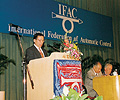 |
 |
 |
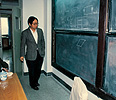 |
|
| Picture6 |
Picture7 |
Picture8 |
Picture9 |
|
Picture 6 In July 1999, the 14th IFAC held in Beijing, organized by the Institute of Systems Science. The photo
shows that the Chairman of the Program Committee, Professor Chen Hanfu is making a speech.
Picture 7 In August 1999, the 15th IFORS held in Beijing, organized jointly by the Institute of Applied Mathematics.
Picture 8 Professor S.S.Chern made an academic speech.
Picture9 Professor Stephen Yao made an academic speech.
 |
 |
 |
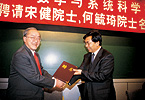 |
|
| Picture10 |
Picture11 |
Picture12 |
Picture13 |
|
|
|
Picture 10The Institue of Mathematics engaged S.S.Chern as an honorary professor.
Picture 11The Institute of Mathematics engaged H.Brezis as an honorary professor.
Picture 12AMSS engaged Song Jian as an honorary professor.
Picture 13AMSS engaged Y.C.Ho as an honorary professor.
Part Five Personnel Training
The Institute of Mathematics has a fine tradition of respecting teachers, of valuing education, and of attaching great importance to personnel training. The institute once set up a "boxing practicing field" for young scholars to exchange views. In 1956, the institute enrolled the first batch of graduate students. But before the "cultural revolution," less than 20 people were enrolled for the graduate study. In 1978, the graduate study system was resumed, and the institute enrolled 24 graduate students selected from more than 1,500 people. Since then, personnel training had been systemized, and the institute became a key base of the CAS to train students toward doctor's degree. Since 1978, nearly 1,000 students got the master's degree, more than 500 students got the doctor's degree, and more than 100 scholars conducted post-doctoral study in the four institutes. A number of outstanding young mathematicians have emerged. Three of them were elected academicians of the CAS; two were honored as "Top Ten Outstanding Youth"; two won the Young Scientist Award of China; one won the National May 4th Medal; three became chief scientists of "973" projects; 20 obtained the financial support from the State Outstanding Youth Fund; 8 won Hong Kong's "Qiushi" Award for Outstanding Young Scholars; 10 won the first-class prize of the CAS Young Scientists; and 17 were supported by the "Hundred Talents Program". |
|
Picture 1 Professor Xu Guozhi and his students.
Picture 2 Professor Lin Qun and his students.
Picture 3 Professor Feng Kang and his student Yu Dehao.
Picture 4 Professor Wu Wentsun and his student Gao Xiaoshan.
Picture 5 Professor Chen Hanfu and his student Zhang Jifeng. |
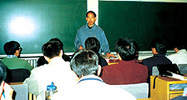 |
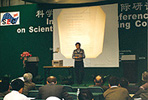 |
 |
 |
 |
| Picture6 |
Picture7 |
Picture8 |
Picture9 |
Picture10 |
Picture 6 Professor Yan Jiaan made lecture for postgraduates.
Picture 7 Professor E Weinan was a graduate student of 1982 grade under the guidance of Huang Hongci.
Picture 8 Professor Liu Kefeng of California University at Los Angeles was a graduate student of 1983 grade
under the guidance of Lu Qikeng.
Picture 9 Professor Guan Pengfei was a graduate student of 1982 grade under the guidance of Lu Qikeng.
Picture 10Professor Du Dingzhu of Minnesota University was a graduate student of 1978 grade under the
guidance of Yue Minyi. |
|
| | | | |
|
|
